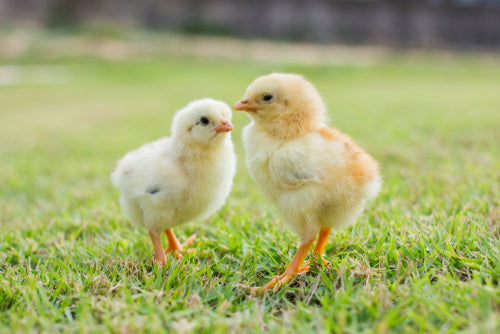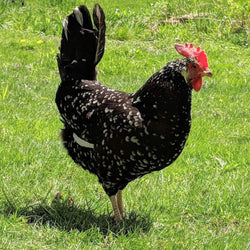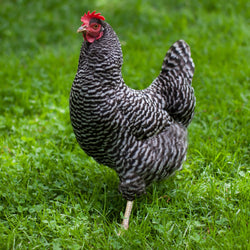page=2/--
Frequently Asked Questions
Here we answer the most commonly-asked questions about ordering, chicken care, and more.
What is the deep litter method of coop bedding management, and how does it work?
The traditional way to manage bedding in the coop is to put a light layer of bedding down--for bedding recommendations, see the related questions below--and then change out the bedding once a day or once every few days. (How often you'll have to clean depends on how many chickens you're keeping in how much space.) It's pretty straightforward; you more or less clean it like a cat litter box. By contrast, in the deep litter method, you start with five or six inches of organic, compostable bedding such as pine shavings, and then simply add new bedding on top to...
Read MoreHow much space should my chickens have inside their coop?
A chicken coop is any structure in which your chickens shelter. In most areas of the country, a chicken coop is an enclosed space, but in warmer areas many people use a three sided coop to make sure it doesn't get too hot inside (the last side of the coop is usually secured with something like welded wire hardware cloth). A coop can be made of plastic, wood, metal or fiberglass. It can be made of recycled pallets, or it can be a re-purposed playhouse. It can be built by hand or purchased. Chicken coops usually contain nests for laying...
Read MoreWhy do chicken combs look so different from one another, and what is a comb?
A comb is the fleshy (usually) red erectile tissue on top of a chicken's head. Different breeds have different combs. There are a few main comb types. A single comb is probably what you think of when you think of a chicken's comb. It has a single row of spiky fingers sticking up from a "blade." But all single combs are not alike. Some can be large and others quite small. Not only does it vary by breed, but it also varies by individual.This is why the size of a comb is not a good way to tell roosters from...
Read MoreThere are so many different terms for chickens--juvenile, cockerel, pullet, chick, hen, rooster, peep, biddy, started pullet, point-of-lay pullet, broody, brood, flock---what do they all mean?
There ARE a lot of different terms for chicken, aren't there? It can be a little confusing, especially when you're just starting out. So let's define these terms. Male and female chicken terms Hen, rooster, roo, capon, chicks, peeps: You probably know the terms "hen" and "rooster," which refer to female chickens and male chickens respectively. "Roo" is just short for "rooster," and "capon" refers to a neutered rooster. What you may not know is that we don't normally refer to young chickens or chicks by those terms. A baby chick is not a hen or a rooster. "Hen" and...
Read MoreWhat's the difference between Breeds, Designer Chicken Breeds, and Varieties of chicken?
Let's talk about Designer Chicken Breeds, Breeds, and Varieties, so you'll understand the differences in terminology. Designer Chicken Breed There are two main differences between Designer Breeds and real Breeds: Designer chicken breeds will not breed true, and they are not American Poultry Association (APA) recognized. Not recognized A Designer chickens such as Favaucanas are not an APA-recognized chicken breed, the same way a Goldendoodle---crossing a Golden Retriever and a Poodle---is not an American Kennel Club (AKC) recognized dog breed. That is to say: they are recognized in the sense that you've probably heard of them, but Favaucanas and Goldendoodles...
Read MoreWhat are frizzles, sizzles, and frazzles?
Frizzles and sizzles are not breeds of chickens so much as they are words describing three very showy feather types that chickens can exhibit. Most pet chicken aficionados, for example, know what Silkies are. They are a breed of chicken with a feather type that is lacking in the barbicels that help the feather keep its tidy shape. So, silkie feathers end up looking very much like fur--and their feathers feel a lot like fur, too! The Silkie chicken breed is named after its feather type. This White Silkie is showing off her unique feather type. There are other unusual...
Read MoreWhat does "straight run" mean?
Straight run chicks are an "as hatched" mix of male and female chicks. Over large numbers (hundreds or thousands), the hatching ratio of straight run orders averages out to be a 50-50 mix, but with small orders the ratio can vary considerably. For instance, if you were to order eight straight run chicks, you will get between zero and eight roosters and between zero and eight hens--there is no way to tell. Hope for the best, but be prepared for the worst! So keep in mind that it's possible to order 8 straight run chicks and end up with 8...
Read MoreWhat are a chicken's hackles?
A chicken's hackle feathers are the feathers around the neck. These feathers can sometimes be showy in roosters. People that "fly tie" (for trout fishing) usually use long, slender hackle feathers from a rooster. Hackles are actually differently shaped in hens and roosters. Rooster hackles are longer and pointier. But don't be fooled. Hen hackles can look a little pointy, too. However they're not as thin or as long as rooster feathers. Take a closeup look at hen hackles: Now here's a closeup of rooster hackles to compare: Notice that you can really tell more of a difference in the...
Read More







"The Clubhouse" Coop
Easy to assemble and built to last, the Clubhouse Coop is the perfect starter coop for a small flock.











